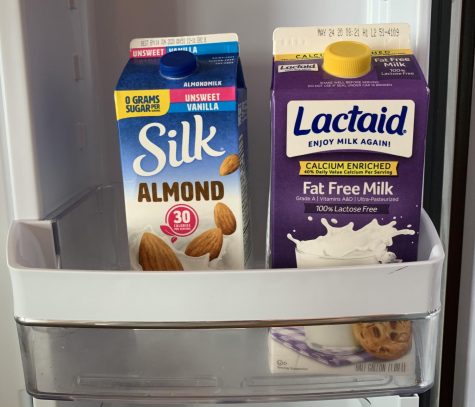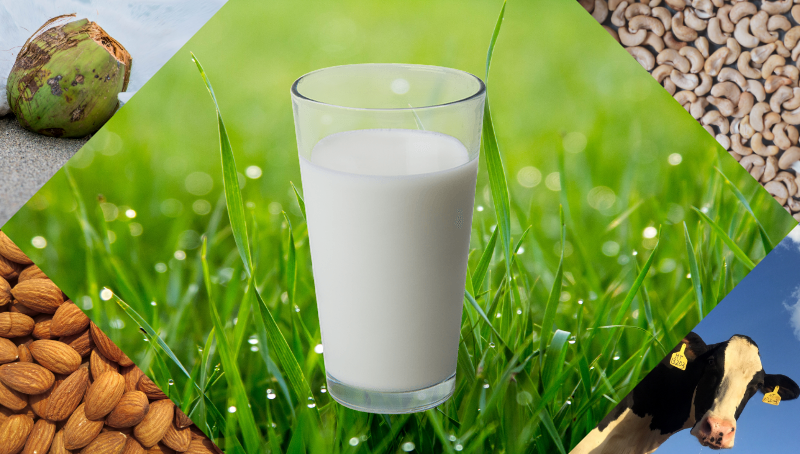Which Milk Alternative is Best For You?
April 8, 2020
No matter what, there will always be an effort to find the healthiest alternative. Whether its egg replacement, or using margarine instead of butter, people will always search for the healthiest option for their family. So it was no surprise when the late 2010’s brought a new health alternative into light: milk.
There are several reasons as to why some people are ditching standard cows milk. The first is that some people are lactose intolerant, meaning they are unable to digest lactose, causing indigestion, bloating, and more. Many people also believe that dairy products can lead to acne, especially in teenagers. The dairy industry is also harming the environment. Dairy milk production requires more land use and water use than any other milk alternative. It also produces the most greenhouse gas emissions. A rise in veganism has also led to the decline of cows milk. As of 2020, there are over 1.5 million vegans in the U.S.
“I don’t drink milk because it is meant for the calf. To get a cow’s milk, the cow has to be artificially inseminated. Then once it gives birth it is separated immediately from its calf. To me, that is inhumane. It is also really bad for the environment because the cows’ manure produce greenhouse gas emissions that contribute to climate change. There are so many other options for milk that are cruelty free and don’t effect climate change as much,” says Danielle Finster (‘20).
People have been saying almond milk is bad for the environment due to water use so I’ve been wondering how bad. Well… not nearly as bad as dairy milk but much worse than soy and oat. https://t.co/s0x5G6Uw0Z pic.twitter.com/JVi4BGqZWm
— pitdesi (@pitdesi) January 13, 2020
With so many options to replace dairy milk, it can be difficult to navigate which alternative is best for you. So here are the six most popular milk alternatives, and the pros and cons of each. All nutritional values are based on an 8-ounce glass serving.
Cow’s milk.
For reference for the rest of these alternatives, Cow’s milk has 150 calories per serving. It has 5 grams of saturated fat, 8 grams of protein, 12 grams of sugar and is 30% of your daily value of calcium. Cows milk is high in protein and calcium, however it is also high in fat content, calories, and sugar. It is also the most wasteful, requiring the most land and water of any dairy/non-dairy milk.
Low-fat milk.
Low fat milk contains 90 calories per serving. It has no saturated fat, 8 grams of protein, 12 grams of sugar and has 30% of your daily value of calcium. Low-fat milk is healthier in terms of less fat and less calories. However, The sugar amount and the calcium amount is the same, and there is still lactose in it. Low-fat milk also uses the same amount of water and land use, and still the same amount of emissions,
Cashew milk.
Cashew milk contains 60 calories per serving. It has no saturated fat, less than 1 gram of protein, 7 grams of sugar and has 45% of your daily value of calcium. Cashew milk has a similar texture to cow’s milk, with more protein. People also like it because it can easily be made at home. If you don’t make your own cashew milk, store bought options are often low in protein and expensive. Like almonds, cashews are also a water intensive crop so a lot of water goes into the production of making cashew milk.
Soy milk.
Soy milk contains 110 calories per serving. It has 0.5 grams of saturated fat, 8 grams of protein, 6 grams of sugar, and 45% of your daily value of calcium. Soy milk is great for those looking for a low fat alternative with high calcium content. It also has a lot of protein. However, soy milk is not accessible for everyone, as soy is a common allergy. Several soy milk producers use genetically modified soybeans, so non-organic brands are contaminated with pesticides. Soy milk also emits a lot of CO2 into the air.

“I like the taste of almond milk better than regular milk, so that what I have at my house,” says Jane Ruppel (’22).
Almond milk.
Almond milk contains 60 calories per serving. It has no saturated fat, 1 grams of protein, 7 grams of sugar, and has 45% of your daily value of calcium. Most people love almond milk for the taste, and the fact that it has less sugar and more calcium. However, almond milk production requires a lot of water, as almonds are a water-intensive crop. One glass of almond milk requires nearly 23 gallons of water to produce. In addition, almond milk is low in protein and has less vitamins than cow’s milk.
Coconut milk.
Coconut milk contains 70 calories per serving. It has 4 grams of saturated fat, no protein, 7 grams of sugar, and 10% of your daily value of calcium. Coconut milk is a great source of potassium, and it’s also soy and gluten free. Most will try coconut milk for the taste, and for the low calories. However, coconut milk is one of the most finicky of the alternatives. Often the milk will solidify and separate, so you have to heat it up to make it drinkable. Coconut milk also has a high fat and sugar content, with little protein or calcium.
Oat milk.
Oat milk contains 120 calories per serving. It has 5 grams of saturated fat, 3 grams of protein, no sugar, and 25% of your daily value of calcium. Several people prefer oat milk for its taste. Oat is a type of grain, so they’re filled with fiber, plant-based protein, B vitamins, and minerals, including iron, calcium, and magnesium. Oats have been shown to reduce cholesterol levels and risk of heart disease. In addition, oat milk is better for the environment, producing 80% less greenhouse gas emissions than dairy milk. However, oat milk has more calories than other milk alternatives. It is also more expensive, and has less calcium and less protein than dairy milk.
Each milk alternative may work for different reasons. If you’re looking for a milk high in calcium and protein, soy or low-fat milk may be best. For those looking for a low sugar option, oat milk is best. It’s also important to note that these are not the only options when it comes to replacing milk. There are dozens of options, these are just some of the most popular. Each individual person will have their own reasons for choosing what works for them, it’s all in the name of health.

